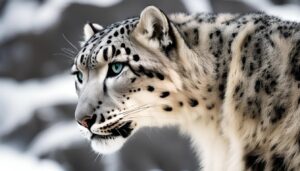Snow Leopard The Ghost of the Mountains
The snow leopard, often referred to as the “ghost of the mountains,” is one of the most elusive and mysterious big cats in the world. With its thick, smoky-gray fur and piercing blue-green eyes, this majestic predator is perfectly adapted to its harsh, mountainous habitat.
The Habitat of the Snow Leopard
Snow leopards are native to the rugged mountain ranges of Central and South Asia, including the Himalayas, the Tibetan Plateau, and the mountains of Mongolia and Russia. These regions, often at altitudes of 3,000 to 5,000 meters (9,800 to 16,400 feet), are characterized by steep cliffs, deep ravines, and snowy peaks—making them an ideal home for this solitary feline.

Physical Characteristics and Adaptations
The snow leopard’s thick fur, which can be up to five inches long, provides essential insulation against the freezing temperatures of its high-altitude environment. The fur’s coloration, a mix of gray, white, and black, offers excellent camouflage against the rocky terrain.
One of the most notable features of the snow leopard is its long, thick tail, which serves multiple purposes. Not only does it help the animal maintain balance while navigating steep slopes, but it can also be wrapped around the body like a scarf for additional warmth during cold weather.
Another key adaptation is the snow leopard’s large paws, which act like natural snowshoes. These paws help distribute the animal’s weight more evenly across the snow, preventing it from sinking into the soft surface.
Diet and Hunting Behavior
Snow leopards are carnivores, with their diet primarily consisting of blue sheep (bharal), ibex, marmots, and other small mammals. They are incredibly powerful hunters, capable of taking down prey three times their own weight. Despite their strength, snow leopards are known for their stealth and patience, often stalking their prey for hours before launching a surprise attack.
Their hunting technique involves ambushing their prey from above, using the element of surprise to their advantage. After a successful kill, a snow leopard may drag its prey to a secluded location to eat, often returning to the same kill multiple times over several days.
Reproduction and Lifespan
Snow leopards are generally solitary animals, coming together only during the mating season, which occurs between January and March. After a gestation period of about 90-100 days, the female gives birth to a litter of one to three cubs in a well-hidden den. The cubs are born blind and rely entirely on their mother for the first few months of their lives.
As they grow, the cubs begin to accompany their mother on hunting trips, learning the skills necessary to survive in the wild. By the time they are about 18-22 months old, they leave their mother to establish their own territories.
In the wild, snow leopards have a lifespan of around 10-12 years, though they can live up to 20 years in captivity.
Conservation Status
The snow leopard is classified as “Vulnerable” on the International Union for Conservation of Nature (IUCN) Red List, with an estimated population of only 3,500 to 7,000 individuals remaining in the wild. Habitat loss, poaching, and conflict with local herders are among the primary threats to their survival.
Conservation efforts are underway across the snow leopard’s range to protect these incredible animals. Organizations are working to reduce human-wildlife conflict, protect natural habitats, and increase awareness of the snow leopard’s plight.